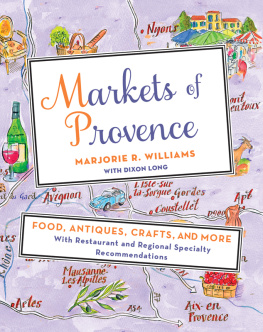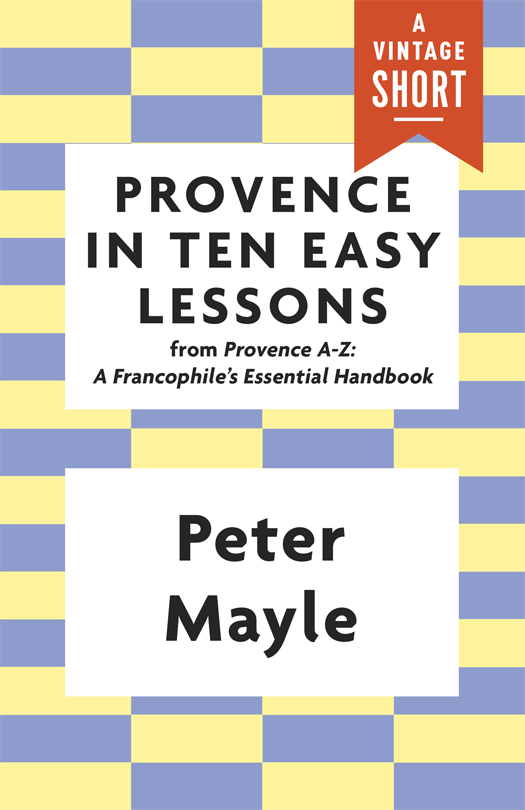Praise for Peter Mayle
[Reading Peter Mayle is] like returning to a country inn where you know the owner, where they save your favorite room for you and the bartender remembers what you drink Provence has been fortunate in its laureates.
The New York Times Book Review
Peter Mayle [is] something of a wonder chronicling the scene around him in irresistible prose [and giving us] the joys of a bountiful climate, brilliant sun, and a splendid cuisine.
Time
Mayles prose is as pure and welcoming as a glass of the house wine at a Provenal caf.
The Philadelphia Inquirer
So evocative you can almost feel the bib tied around his chin and sip the last drop of Bordeaux at the bottom of his glass.
The Washington Post
Foodies and Francophiles will discover a like-minded devotee. And all but the strictest vegetarian will be made hungry Mayles form is every bit as good as ever.
Associated Press
Mayles descriptions are as mouthwatering as the food he samples. He captures the comic while never depreciating the subject.
Rocky Mountain News
Mayle makes Provence sound like the most enticing place this side of paradise. Reservations, anyone?
People
Provence in Ten Easy Lessons
PETER MAYLE
A Vintage Short
Vintage Books
A Division of Random House LLC
New York
A VINTAGE DEPARTURES ORIGINAL, MARCH 2014
Copyright 2014 by Escargot Productions, Ltd.
All rights reserved. Published in the United States by Vintage Books, a division of Random House LLC, New York, and in Canada by Random House of Canada Limited, Toronto, Penguin Random House companies.
Vintage is a registered trademark and Vintage Departures and colophon are trademarks of Random House LLC.
This eBook has been adapted from Provence A to Z by Peter Mayle, copyright 2006 by Escargot Productions, Ltd. Originally published in hardcover in the United States by Alfred A. Knopf, a division of Random House LLC, New York, in 2006.
This is a work of fiction. Names, characters, places, and incidents either are the product of the authors imagination or are used fictitiously. Any resemblance to actual persons, living or dead, events, or locales is entirely coincidental.
eBook ISBN: 978-0-8041-7220-2
www.vintagebooks.com
v3.1_r2
To Aristide Farigoule,
the human encyclopedia
CONTENTS
INTRODUCTION
I am now in the land of corn, wine, oil, and sunshine. What more can man ask of heaven?
Thomas Jefferson, Aix-en-Provence, March 27, 1787
Its not easy, trying to squeeze Provence into a few short highlights. Theres too much material, too much history: thousands of years of human habitation, an encyclopedias worth of chteaux, a small army of distinguished or notorious residents, from Nostradamus to the Marquis de Sade; artists, writers, and poets galore. Van Gogh and Czanne, Pagnol and Daudet; legends and myths, mountains and vineyards, truffles and melons, saints and monsters. Where to start? What to include? What to leave out?
Its a problem that many writers have faced, and their solution has often been to specialize. They have confined themselves to particular subjectsecclesiastical architecture, the influence of the Romans, the cultural significance of bouillabaisse, any one of a hundred facets of Provenceand they have produced comprehensive, often scholarly books. Admirable though these are, I havent attempted to add to that collection. Probably just as well, since Im no scholar.
Instead, Ive put together an autobiographical jigsaw of personal interests, personal discoveries, and personal foibles. But I have at least observed certain rules and restrictions. I have avoided the more celebrated landmarks, buildings, and monuments. I have left to others the Pont du Gard, the Roman amphitheater of Arles, the Abbey of Snanque near Gordes, the Palais des Papes in Avignon, and dozens of other historic marvels that have been so frequently admired and so well described. For the same reason, I have decided not to include great tracts of glorious countryside, like the Camargue, and one of the most beautiful stretches of the Provenal coastline, the Calanques east of Marseille.
To take their place, Ive selected some of the simple, everyday pleasures of Provenal life that any visitor can share and enjoy. Ive kept to subjects that interest or amuse me, in the hope that my imaginary visitor will also find them interesting or amusing. Its the technique of the magpie, hopping from one promising distraction to another.
During my research, I have often been reminded of the Provenal love of anecdote, conversational embroidery, and the barely credible story. (In Ireland, this would be called blarney.) I make no excuses for recording much of what Ive been told, however unlikely it may sound. We are, after all, living through a period in which the truth is routinely distorted by governments and politicians. If I have sometimes overstepped the bounds of verifiable accuracy, at least I have done so in a good cause, which is to make the reader smile.
For the same reason, I have not questioned too closely some of the specialist information passed on to me by experts, and Provence is full of experts. Almost without exception, they are generous with their time, their advice, and their opinions. The problem comes when you ask two of these experts the same question. What is the best time to pick olives? How can I keep scorpions out of the bathroom? Is pastis the cure for all ills? Invariably, you will receive conflicting answers, each delivered with enormous conviction. I admit that I always choose to believe the most improbable one.
Among these experts, one in particular deserves to be mentioned here, the emeritus professor Monsieur Aristide Farigoule. Now retired from the mainstream of academic life, he has established a charitable course for the education of backward foreigners, and I am his favorite pupil; in fact, I think I may be his only pupil. Lessons are held in the local caf, and the curriculum is remarkably wide-ranging, since Monsieur Farigoule seems to be an expert on everything. Among other things, I have tried him on hornets nests, Napolons love life, the use of donkey dung as fertilizer, the poetry of Mistral, the essential character differences between the French and the Anglo-Saxons, and the Avignon Papacy. He has never been short of an answer, is usually contentious, and is always extremely opinionated. It is to this unconventional muse that I owe a considerable debt, which I now acknowledge with great pleasure.
1.
VISITING HOURS
When is the best time to visit Provence? I must have been asked this a hundred times, and each time Ive had to answer with a question: What do you want to do? July and August are fine for tanning addicts, watching Parisians at play, and catching up with the Avignon festival. These months are not so good for sightseeing expeditions, deserted beaches, and getting into a good restaurant without making a reservation. Several million people visit France each year, and I have known times during high summer when it felt as though most of them had come down to my village for the Friday-morning market.
The rest of the year is calmer and less hot, and each season offers its own particular pleasures. Let me give you a few sketches of what you can expect.
Winter
Unpicked almonds, black on leafless branches. Clipped vines poking twisted fingers through the bare, brown earth. Winter sunsets, livid and panoramic, followed by a low and bloody moon. Steam rising from a horses back. Fields white with flowering wild






